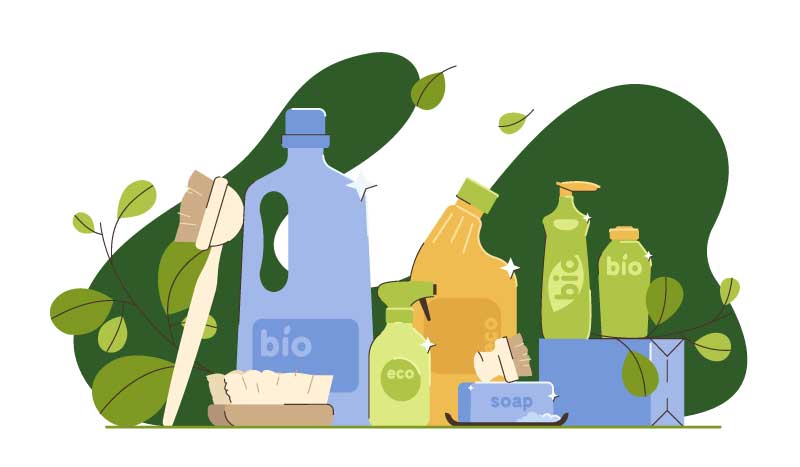The term “eco-friendly” refers to products and activities that are safe for the environment, causing no harm during use or disposal. In essence, it signifies practices that do not contribute to air, water, or soil pollution, making it a crucial concept for preserving the planet.
Eco-friendly products are specifically designed to minimize environmental and ecological harm throughout their production, use, and disposal. They play a key role in mitigating climate change, reducing pollution, and conserving natural resources. Common examples include reusable bags, sustainable sanitary pads, and eco-friendly kitchenware, which are practical and easily incorporated into daily life. These products are gaining popularity not only for their environmental benefits but also for their cost-effectiveness and positive impact on health.
This study explores the concept of eco-friendliness, the characteristics and types of eco-friendly products, and the advantages they offer to both people and the environment. By highlighting these aspects, we aim to raise awareness about the importance of sustainable consumption and identify practical ways to integrate eco-friendly products into everyday life (Jain, 2022).
Advantages of eco-friendly products
Eco-friendly products have the advantage of reducing costs in the long term. Appliances and reusable items that reduce energy and water consumption may have a higher initial cost but can reduce utility bills and living expenses over time. In addition, it contributes to environmental protection by reducing carbon footprints and reducing waste, and it has a positive impact on user health due to the decreased use of chemicals that are harmful to health. Many eco-friendly products, such as solar panels and energy-efficient appliances, qualify for government incentives and tax credits, further reducing costs. Sustainable materials like bamboo and recycled plastics help conserve natural resources and reduce landfill waste. Companies adopting eco-friendly practices often enhance their brand reputation, attracting environmentally conscious consumers. Moreover, biodegradable and non-toxic materials minimize pollution and promote a healthier ecosystem for future generations.
Disadvantages of eco-friendly products
However, eco-friendly products have the disadvantage of high initial costs, which can be an economic burden. Products are often difficult to obtain, and additional costs and carbon emissions may occur during delivery. In addition, reusable products are cumbersome to use and manage, making them less convenient than existing products (Kristi, 2016). Some eco-friendly alternatives, such as electric vehicles and organic foods, may have limited availability depending on location. The production process for certain sustainable goods can still have environmental drawbacks, such as requiring more resources or specialized facilities. Additionally, some biodegradable materials degrade more slowly under certain conditions, leading to waste accumulation. Consumers may also face misleading “greenwashing” claims, where products are marketed as eco-friendly without meeting sustainability standards.
Challenges and Impacts of Eco-Friendly Products
One of the main challenges of eco-friendly products is the difficulty in determining their true environmental impact. First, there is no universally accepted definition of “eco-friendly,” and terms like “natural” and “organic” are often used misleadingly, making it hard for consumers to make informed choices. Second, the broad range of eco-friendly products creates confusion, as items made from organic or recycled materials are frequently labeled as sustainable without clear standards to verify their claims. Third, a lack of transparency in production processes and sourcing makes it challenging for consumers to assess whether a product aligns with ethical and environmental values.
Additionally, consumers often struggle to find a balance between affordability, quality, and sustainability. If eco-friendly alternatives are significantly more expensive or less durable than conventional products, the financial burden may deter widespread adoption. Moreover, access to reliable information about sustainable living is limited, making it difficult for consumers to incorporate eco-friendly choices into their daily routines. Governments and organizations can play a key role in addressing these issues by implementing stricter regulations on eco-labeling, promoting sustainable innovations, and improving public awareness. Increased transparency and education can help consumers make more responsible choices while encouraging businesses to adopt genuinely sustainable practices (Eco, 2022).
Conclusion
Eco-friendly products play a crucial role in protecting the environment and promoting healthier lifestyles. However, challenges such as high initial costs, lack of transparency, and inconvenience in daily use make it difficult for consumers to fully embrace sustainable alternatives. Addressing these issues requires efforts to improve product accessibility, provide clearer information, and simplify the adoption of eco-friendly choices in everyday life. Governments and businesses must collaborate to establish standardized regulations, ensuring that eco-friendly claims are accurate and verifiable. Additionally, advancements in technology and sustainable production methods can help lower costs and enhance the quality of eco-friendly products. Ultimately, fostering a culture of sustainable consumption benefits not only the environment but also the well-being of individuals and future generations.
References
Eco, A., 2022. What are the problems encountered by consumers using eco-friendly products?. [online] Medium. Available at: https://medium.com/@authority.eco/what-are-the-problems-encountered-by-consumers-using-eco-friendly-products-2fbc3b01ad18 [Accessed 25 January. 2025].
jain, P., 2022. Importance of Eco Friendly Products. [online] Green Feels. Available at: https://greenfeels.in/blogs/sustainability-basics/importance-of-eco-friendly-products?srsltid=AfmBOoopJOYeu0gpDIAaplvcWciJ2BBHOdwyJPP5OjxjGn7OFUDjX7Op [Accessed 4 January. 2025].
Kristi, 2016. Pros and Cons of Eco-Friendly Products. [online] Young Adult Money. Available at: https://www.youngadultmoney.com/pros-and-cons-of-eco-friendly-products/ [Accessed 25 Janualy. 2025].
